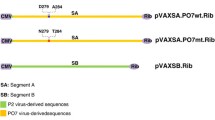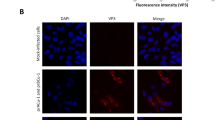Abstract
A cell-culture-adapted reverse genetics strain of very virulent infectious bursal disease virus (IBDV) of chickens, designated as BD-3tcC, having four amino acid substitutions (Gln253His, Asp279Asn, Ala284Thr and Ser330Arg) in the capsid protein VP2 was tested for its genetic stability during serial passage in chickens and chicken embryo fibroblast (CEF) cell culture. Results of in vitro and in vivo experiments demonstrated that all four introduced mutations in BD-3tcC remained stable during serial passage in CEF cell culture, but during passage in chickens, amino acid residues at position 253 and 284 reverted from histidine to glutamine and threonine to alanine, respectively. In a parallel experiment, the same substitutions also occurred in a conventionally attenuated vaccine strain D-78 on serial passage in chickens. However, no reversion or substitution took place at positions 279 and 330 during in vivo passage of the mutant virus BD-3tcC or vaccine virus D-78. The findings provide conclusive evidence that while IBDV requires histidine and threonine at positions 253 and 284 for cell culture adaptation, glutamine and alanine at these positions are selected preferentially during in vivo replication.


Similar content being viewed by others
References
Badhy SC, Das PM, Islam MR (2004) Detection and characterization of infectious bursal disease virus of chickens by RT-PCR and restriction enzyme analysis. Bangladesh Vet J 38:43–52
Bayliss CD, Spies U, Shaw K, Peters RW, Papageorgiou A, Müller H, Boursnell MEG (1990) A comparison of the sequences of segment A of four infectious bursal disease virus strains and identification of a variable region in VP2. J Gen Virol 71:1303–1312
Brandt M, Yao K, Liu M, Heckert RA, Vakharia VN (2001) Molecular determinants of virulence, cell tropism, and pathogenic phenotype of infectious bursal disease virus. J Virol 75:11974–11982
Chettle N, Stuart JC, Wyeth PJ (1989) Outbreak of virulent infectious bursal disease in East Anglia. Vet Rec 125:271–272
Coulibaly F, Chevalier C, Delmas B, Rey FA (2010) Crystal structure of an aquabirnavirus particle: Insights into antigenic diversity and virulence determinism. J Virol 84:1792–1799
Coulibaly F, Chevalier C, Gutsche I, Pous J, Navaza J, Bressanelli S, Delmas B, Rey FA (2005) The birnavirus crystal structure reveals structural relationships among icosahedral viruses. Cell 120:761–772
Da Costa B, Chevalier C, Henry C, Huet JC, Petit S, Lepault J, Boot H, Delmas B (2002) The capsid of infectious bursal disease virus contains several small peptides arising from the maturation process of pVP2. J Virol 76:2393–2402
Delgui L, Ona A, Gutierrez S, Luque D, Navarro A, Caston JR, Rodriguez JF (2009) The capsid protein of infectious bursal disease virus contains a functional alpha 4 beta 1 integrin ligand motif. Virology 386:360–372
Delmas B (2008) Encyclopaedia of Virology, 3rd edn., vol. 1. Elsevier, Oxford. pp 321–328
Dobos P, Hill BJ, Hallett R, Kells DT, Becht H, Teninges D (1979) Biophysical and biochemical characterization of five animal viruses with bisegmented double-stranded RNA genomes. J Virol 32:593–605
Durairaj V, Sellers HS, Linnemann EG, Icard AH, Mundt E (2011) Investigation of the antigenic evolution of field isolates using the reverse genetics system of infectious bursal disease virus (IBDV). Arch Virol 156:1717–1728
Escaffre O, Le Nouën C, Amelot M, Ambroggio X, Ogden KM, Guionie O, Toquin D, Müller H, Islam MR, Eterradossi N (2013) Both genome segments contribute to the pathogenicity of very virulent infectious bursal disease virus. J Virol 87:2767–2780
Garriga D, Querol-Audi J, Abaitua F, Saugar I, Pous J, Verdaguer N, Caston JR, Rodríguez JF (2006) The 2.6-Angstrom structure of infectious bursal disease virus-derived T=1 particles reveals new stabilizing elements of the virus capsid. J Virol 80:6895–6905
Islam MR, Zierenberg K, Eterradossi N, Toquin D, Rivallan G, Müller H (2001) Molecular and antigenic characterization of Bangladeshi isolates of infectious bursal disease virus demonstrates their similarities with recent European, Asian and African very virulent strains. J Vet Med B 48:211–221
Islam MR, Zierenberg K, Raue R, Müller H (2001) Molecular cloning and sequencing of a Bangladeshi strain of very virulent infectious bursal disease virus and its adaptation to tissue culture by site directed mutagenesis. Proceedings of the II International Symposium on Infectious Bursal Disease and Chicken Anaemia, 16–20 June, 2001, Rauischholzhausen, Germany. pp 30–39
Jackwood DJ, Sreedevi B, LeFever LJ, Sommer-Wagner SE (2008) Studies on naturally occurring infectious bursal disease viruses suggest that a single amino acid substitution at position 253 in VP2 increases pathogenicity. Virology 377:110–116
Lange H, Müller H, Käufer I, Becht H (1987) Pathogenic and structural properties of wild type infectious bursal disease virus (IBDV) and virus grown in vitro. Arch Virol 92:187–196
Lee CC, Ko TP, Chou M, Yoshimura CC, Doong SR, Wang MY, Wang AH (2006) Crystal structure of infectious bursal disease virus VP2 subviral particle at 2.6 Å resolution: implications in virion assembly and immunogenicity. J Struct Biol 155:74–86
Leong JC, Brown D, Dobos P, Kibenge F, Ludert JE, Müller H, Mundt E, Nicholoson B (2000) Birnaviridae. In: Regenmortel MHV, Fauquet CM, Bishop DHL, Carstens EB, Estes MK, Lemon SM, Maniloff J, Mayo MA, McGeoch DJ, Pringle CR, Wickner RB (eds) Virus Taxonomy: Classification and Nomenclature of Viruses. Academic Press, New York, pp 481–490
Letzel T, Coulibaly F, Rey FA, Delmas B, Jagt E, van Loon AAMW, Mundt E (2007) Molecular and structural bases for the antigenicity of VP2 of infectious bursal disease virus. J Virol 81:12827–12835
Lim BL, Cao Y, Yu T, Mo CW (1999) Adaptation of very virulent infectious bursal disease virus to chicken embryonic fibroblasts by site-directed mutagenesis of residues 279 and 284 of viral coat protein VP2. J Virol 73:2854–2862
Lombardo E, Maraver A, Espinosa I, Fernandez-Arias A, Rodriguez JF (2000) VP5, the non structural polypeptide of infectious bursal disease virus, accumulates within the host plasma membrane and induces cell lysis. Virology 277:345–357
Luna LG (1968) Manual of Histopathologic Staining Methods of the Armed Forces Institute of Animals, 3rd edn. McGraw-Hill Book Company, London
Luque D, Saugar I, Rejas MT, Carrascosa JL, Rodriguez JF, Caston JR (2009) Infectious bursal disease virus: ribonucleoprotein complexes of a double-stranded RNA virus. J Mol Biol 386:891–901
McFerran JB, McNulty MS, McKillop ER, Conner TJ, McCracken RM, Collins DS, Allan GM (1980) Isolation and serological studies with infectious bursal disease viruses from fowl, turkey and duck: demonstration of a second serotype. Avian Pathol 9:395–404
Müller H, Becht H (1982) Biosynthesis of virus-specific proteins in cells infected with infectious bursal disease virus and their significance as structural elements for infectious virus and incomplete particles. J Virol 44:384–392
Müller H, Scholtissek C, Becht H (1979) The genome of infectious bursal disease virus consists of two segments of double-stranded RNA. J Virol 31:584–589
Müller H, Islam MR, Raue R (2003) Research on infectious bursal disease: the past, the present and the future. Vet Microbiol 97:153–165
Müller H, Mundt E, Eterradossi N, Islam MR (2012) Current status of vaccines against infectious bursal disease. Avian Pathol 41:133–139
Müller R, Käufer I, Reinacher M, Weiss E (1979) Immunofluorescent studies of early virus propagation after oral infection with infectious bursal disease virus (IBDV). Zentralbl Veterinärmed B 26:345–352
Mundt E (1999) Tissue culture infectivity of different strains of infectious bursal disease virus is determined by distinct amino acids in VP2. J Gen Virol 80:2067–2076
Mundt E, Köllner B, Kretzschmar D (1997) VP5 of infectious bursal disease virus is not essential for viral replication in cell culture. J Virol 71:5647–5651
Mundt E, Beyer J, Müller H (1995) Identification of a novel viral protein in infectious bursal disease virus-infected cells. J Gen Virol 76:437–443
Mundt E, Vakharia VN (1996) Synthetic transcripts of double-stranded Birnavirus genome are infectious. Proc Natl Acad Sci USA 93:11131–11136
Noor M, Lüken C, Das PM, Islam MR, Müller H (2013) Regeneration of a recombinant infectious bursal disease virus having four amino acid substitutions in VP2 by reverse genetics. [Manuscript submitted for publication]
Pous J, Chevalier C, Ouldali M, Navaza J, Delmas B, Lepault J (2005) Structure of birnavirus-like particles determined by combined electron cryomicroscopy and X-ray crystallography. J Gen Virol 86:2339–2346
Raue R, Islam MR, Islam MN, Islam KM, Badhy SC, Das PM, Müller H (2004) Reversion of molecularly engineered, partially attenuated very virulent infectious bursal disease virus during infection of commercial chickens. Avian Pathol 33:181–189
Schnitzler D, Bernstein F, Müller H, Becht H (1993) The genetic basis for the antigenicity of the VP2 protein of the infectious bursal disease virus. J Gen Virol 74:1563–1571
Spies U, Müller H, Becht H (1987) Properties of RNA polymerase activity associated with infectious bursal disease virus and characterization of its reaction products. Virus Res 8:127–140
van den Berg TP, Gonze M, Meulemans G (1991) Acute infectious bursal disease in poultry: isolation and characterization of highly virulent strain. Avian Pathol 20:133–143
van Loon AAWM, de Haas N, Zeyda I, Mundt E (2002) Alteration of amino acids in VP2 of very virulent infectious bursal disease virus results in tissue culture adaptation and attenuation in chickens. J Gen Virol 83:121–129
Yamaguchi T, Kondo T, Inoshima Y, Ogawa M, Miyoshi M, Yanai T, Masegi T, Fukushi H, Hirai K (1996) In vitro attenuation of highly virulent infectious bursal disease virus: some characteristics of attenuated strains. Avian Dis 40:501–509
Yamaguchi T, Ogawa M, Inoshima Y, Miyoshi M, Fukushi H, Hirai K (1996) Identification of sequence changes responsible for the attenuation of highly virulent infectious bursal disease virus. Virology 223:219–223
Yao K, Goodwin MA, Vakharia VN (1998) Generation of a mutant infectious bursal disease virus that does not cause bursal lesions. J Virol 72:2647–2654
Yip CW, Yeung YS, Ma CM, Lam PY, Hon CC, Zeng F, Leung FCC (2007) Demonstration of receptor binding properties of VP2 of very virulent strain infectious bursal disease virus on Vero cells. Virus Res 123:50–56
Zierenberg K, Nieper H, van den Berg TP, Ezeokoli CD, Voss M, Müller H (2000) The VP2 variable region of African and German isolates of infectious bursal disease virus: comparison with very virulent, “classical” virulent, and attenuated tissue culture-adapted strains. Arch Virol 145:113–125
Acknowledgements
The study was supported by the Alexander von Humboldt Foundation through an Institutional Cooperation Project between the Bangladesh Agricultural University, Mymensingh, Bangladesh, and the University of Leipzig, Leipzig, Germany.
Author information
Authors and Affiliations
Corresponding author
Rights and permissions
About this article
Cite this article
Noor, M., Mahmud, M.S., Ghose, P.R. et al. Further evidence for the association of distinct amino acid residues with in vitro and in vivo growth of infectious bursal disease virus. Arch Virol 159, 701–709 (2014). https://doi.org/10.1007/s00705-013-1885-2
Received:
Accepted:
Published:
Issue Date:
DOI: https://doi.org/10.1007/s00705-013-1885-2




